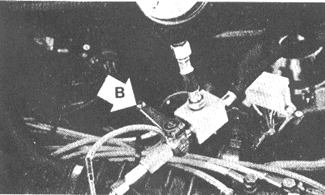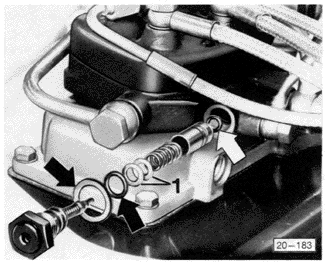System PressureTo measure system pressure, install a pressure gauge as described above and close the valve in the line to the control pressure regulator, as shown in Fig. 5-20. Start the engine and let it idle. System pressure should be 4.7 to 5.4 bar (68 to 77 psi). System pressure is preset during fuel distributor manufacture and should not require routine adjustment.

If system pressure is too low, look for fuel leaks, a clogged fuel filter, or a damaged fuel line blocking fuel flow. Check fuel pump delivery rate as described in 4.3 Fuel Pump. If no other cause for low system pressure can be found, the pressure can be adjusted by adding shims to the pressure relief valve. See Fig. 5-21. An additional 0.50 mm (.020 in.) shim will increase system pressure by about 0.30 bar (4 psi). An additional 1.00 mm (.040 in.) shim will increase it by about 0.60 bar (8 psi).

If system pressure is too high, check for a blocked or damaged fuel return line. If the fuel return line is in good condition, the pressure can be adjusted by reducing the thickness of the shims on the pressure relief valve. See Fig. 5-21 above. A change of 0.50 mm (.020 in.) total shim thickness will decrease system pressure by about 0.30 bar (4 psi). A change of 1.00 mm (.040 in.) total shim thickness will decrease it by about 0.60 bar (8 psi). If the fuel pressure cannot be accurately adjusted, the fuel distributor is faulty and should be replaced. See 5.1 Air Flow Measurement and Fuel Metering. |